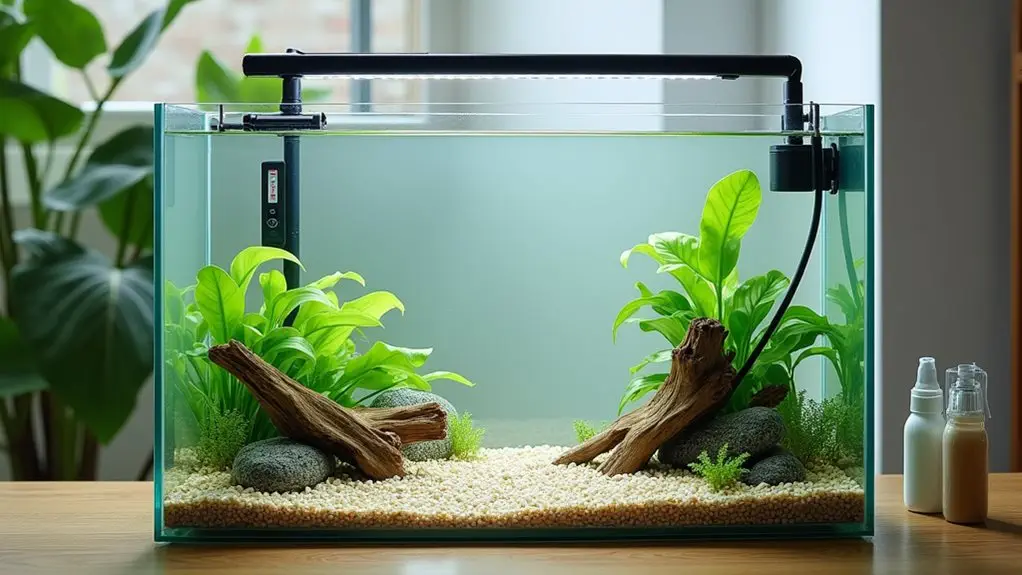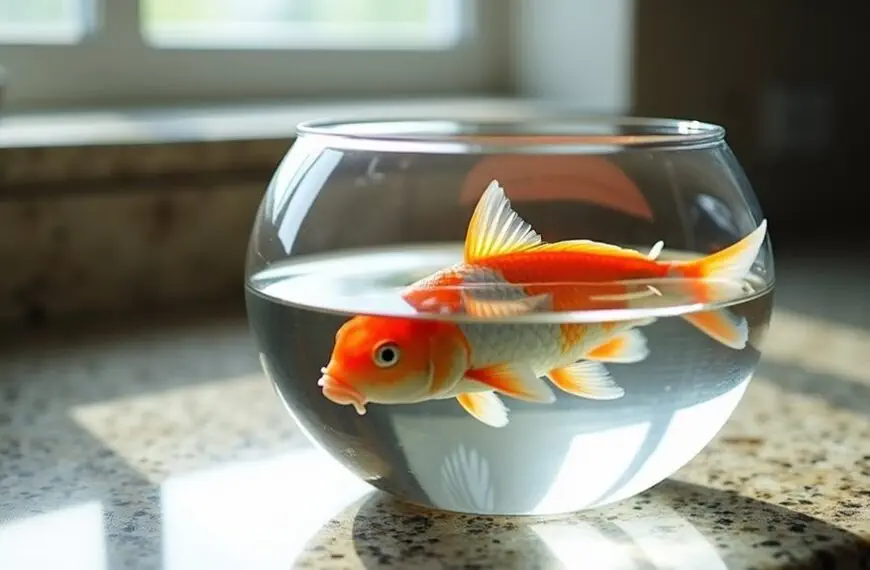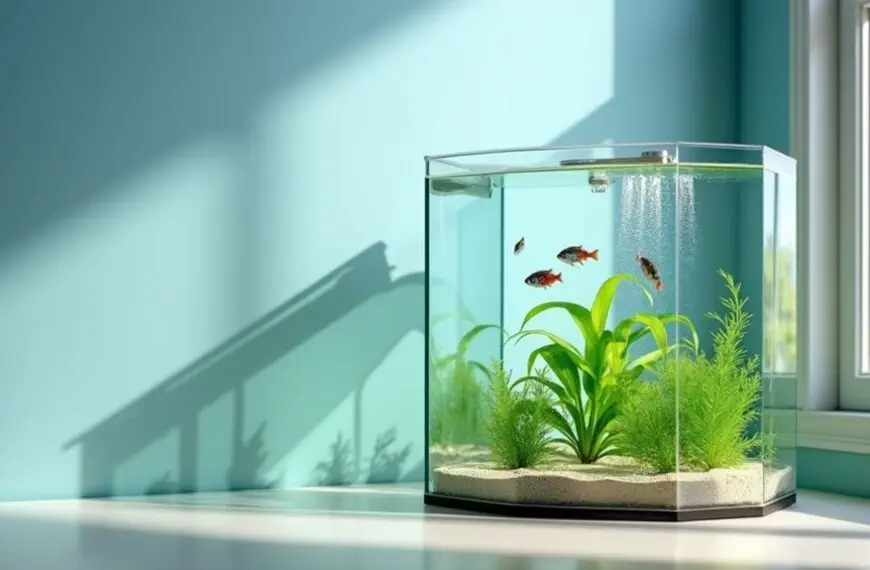Waiting just 24 hours isn't enough when setting up a new aquarium – you'll actually need 4-6 weeks for proper cycling. During this essential period, beneficial bacteria colonies develop to break down harmful waste products that could hurt your fish. While it's tempting to add fish right away, rushing this process often leads to "new tank syndrome," which can be fatal to your finned friends. You'll need to monitor ammonia, nitrite, and nitrate levels while maintaining proper temperature (83-87°F) and pH (7.0-7.8) throughout the cycling process. There's much more to learn about creating the perfect underwater home for your future aquatic family.
Contents
- 1 The 24-Hour Rule Explained
- 2 Proper Tank Cycling Process
- 3 Water Chemistry Fundamentals
- 4 Safe Fish Acclimation Steps
- 5 Tank Setup Best Practices
- 6 Frequently Asked Questions
- 6.1 Can I Add Invertebrates Immediately After Setting up the Tank?
- 6.2 What Happens if Power Goes Out During the 24-Hour Waiting Period?
- 6.3 Should I Adjust Lighting Schedules During the First 24 Hours?
- 6.4 Do Different Fish Species Require Different Waiting Times Before Introduction?
- 6.5 Can Medications or Water Treatments Affect the 24-Hour Waiting Period?
- 7 Final Thoughts
The 24-Hour Rule Explained
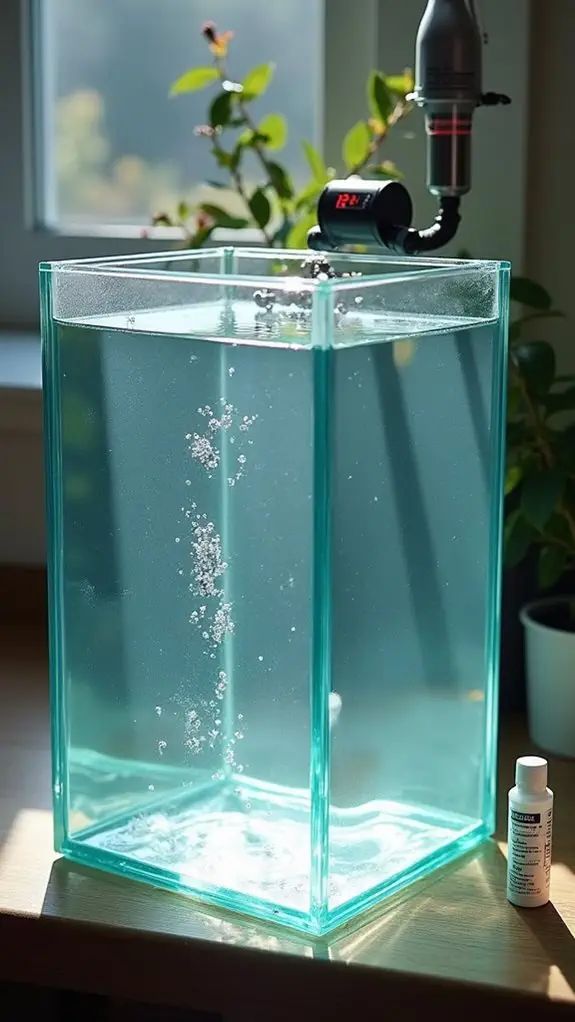
In the world of aquarium keeping, the 24-hour rule represents a controversial shortcut to the traditional cycling process. While you might be enthusiastic to add fish to your new tank right away, it's important to understand what this method really means and why it's sparked so much debate among aquarists.
The traditional cycling process typically takes 4-6 weeks, allowing beneficial bacteria to naturally establish themselves in your tank. However, rapid cycling attempts to speed up this bacterial colonization by using existing filter media, gravel, or commercial bacteria products. Bottled bacteria must be checked for expiration dates to ensure effectiveness. Local fish stores often provide cycled media from their established tanks to help jumpstart the process. During the cycling period, the nitrogen cycle plays a crucial role in maintaining a healthy tank environment.
Think of it like moving into a new house – you can either wait for the paint to dry naturally or try to speed up the process with fans and dehumidifiers.
While the 24-hour method can work in emergency situations, like sudden fish deaths or equipment failures, it's not your best option for starting a new aquarium.
You'll need to be extra vigilant with water testing and be prepared for potential ammonia spikes that could stress your fish. If you're new to the hobby, it's better to practice patience and let nature take its course.
Proper Tank Cycling Process
Building a healthy aquarium environment starts with proper tank cycling, a critical process that establishes beneficial bacteria colonies in your filter system. During this time, it's important to maintain optimal cycling temperature to promote bacterial growth.
You'll find the cycling benefits are worth the wait, as this process creates a stable and safe home for your future fish friends. To begin, you'll need to set up your tank with dechlorinated water and a running filter.
The real magic happens when you introduce an ammonia source – either through fish food, pure ammonia, or hardy starter fish. Your tank will develop two types of helpful bacteria: one that converts ammonia to nitrite, and another that transforms nitrite into less harmful nitrate.
You'll want to monitor these levels with a test kit throughout the process, which typically takes four to eight weeks. New tank syndrome can occur if you rush this process by adding too many fish too quickly. Bacterial colonies are remarkably resilient over time, so you won't need to repeat the cycling process once it's properly established.
During this time, maintain a stable temperature between 83°F and 87°F, and keep your pH between 7.0 and 7.8.
Once your test results show zero ammonia and nitrite with some nitrate present, you've hit the cycling jackpot! Then you can start adding fish gradually, ensuring your newly established bacterial community can handle the bioload.
Water Chemistry Fundamentals
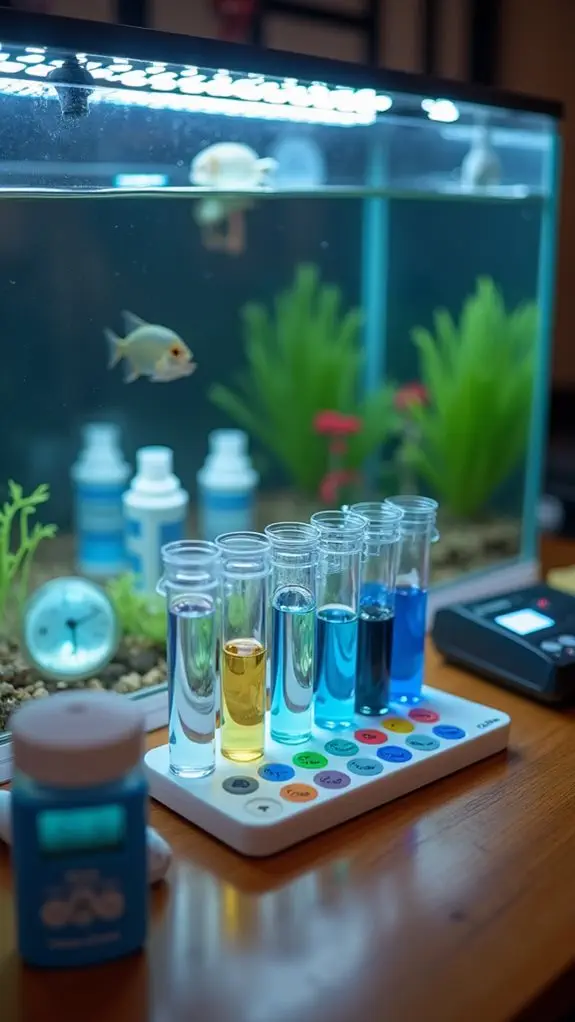
Understanding water chemistry might seem intimidating at first, but it's fundamental for maintaining a thriving aquarium.
You'll need to monitor several water parameters that directly affect your fish's health and happiness, just like you'd keep track of your own essential signs during a check-up.
When you're setting up your tank, you'll want to focus on key measurements like pH stability, temperature, and various nitrogen compounds. Your freshwater fish will typically need a pH between 6.0 and 7.5, and you'll want to keep the temperature steady between 72-82°F, depending on your specific fish species. Maintaining consistent temperature is vital since temperature fluctuations can cause significant stress to your aquatic pets. Additionally, regular testing of your water parameters helps ensure your fish remain healthy and happy. Even though the water may look crystal clear, harmful chemicals can accumulate without being visible to the naked eye.
Think of it as creating the perfect home environment – not too hot, not too cold, and just the right balance of everything.
Water hardness plays a critical role too. It's like the foundation of your aquarium's chemistry, affecting how stable your water parameters remain over time.
You'll need to test your water regularly using simple test kits, and don't worry – it's not rocket science! With a bit of practice, you'll become quite comfortable managing your tank's chemistry.
Safe Fish Acclimation Steps
After carefully selecting your fish, proper acclimation becomes your next crucial step for ensuring their survival in your aquarium.
You'll want to start by turning off both your aquarium and room lights, creating a calming environment that'll help reduce stress on your new aquatic friends. Fish compatibility isn't just about who gets along with whom – it's also about how you introduce them to their new home. Total acclimation time should never exceed two hours. Using a plastic spaghetti strainer can help contain aggressive tank mates during the introduction process. Regular water changes can help maintain fish health in their new environment, making the transition smoother.
When it comes to acclimation techniques, you've got two main options: the floating method and the drip method. For most fish, the floating method works perfectly – just add half a cup of tank water to their bag every four minutes until it's full.
If you're working with sensitive species like corals or invertebrates, you'll want to use the drip method instead, maintaining a steady rate of 2-4 drips per second.
Once your fish are ready for transfer, never dump the bag water into your tank. Instead, net them carefully and release them into their new home.
Keep those lights off for at least four more hours, and start with small feeding amounts – think of it as letting them settle into their new apartment before throwing a dinner party!
Tank Setup Best Practices
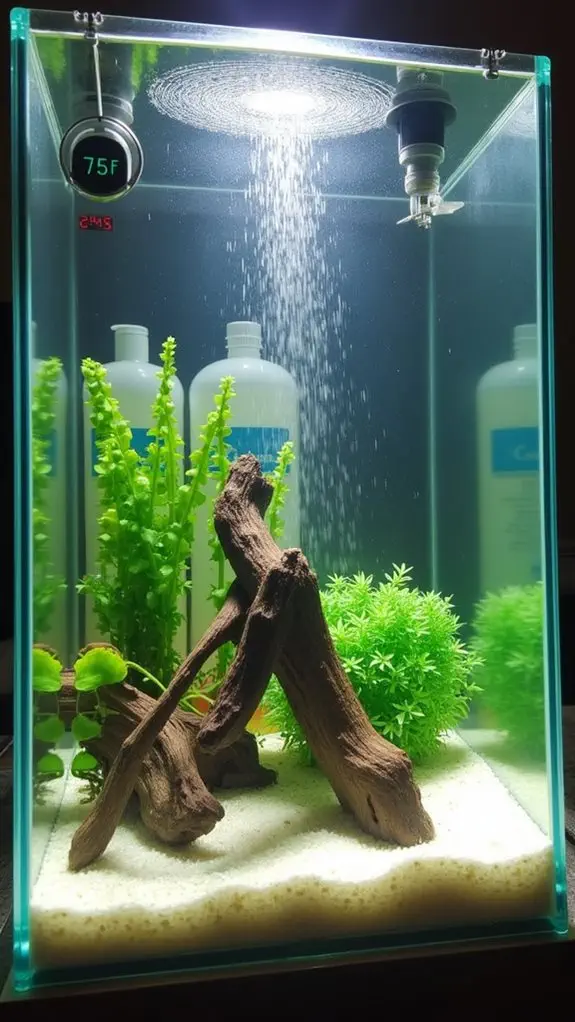
Your tank setup forms the foundation for your fish's long-term health and happiness, well before any acclimation begins. When it comes to tank placement, you'll want to find a stable, level surface away from windows and busy areas – trust me, your fish won't appreciate constant tapping on the glass from curious visitors! Course gravel substrate will help maintain proper water flow through your tank bed.
Getting your equipment installation right is vital for a thriving aquatic environment. Consider installing floor jacks if your tank is particularly large to ensure proper structural support. You'll need to carefully position your filters, heaters, and lights according to manufacturer guidelines. Don't forget to use GFCI outlets or surge protectors – nobody wants an electrical mishap near water!
Start by rinsing everything thoroughly (yes, even those fancy decorations), and then add your substrate. When you're filling the tank, remember to use a dechlorinator – your future fish will thank you.
Before adding any finned friends, you'll want to test all equipment for at least 24 hours. Think of it as a dress rehearsal for your underwater show! This gives you time to spot any leaks, adjust equipment, and verify everything's running smoothly. It's much easier to fix issues in an empty tank than one full of swimming residents.
Frequently Asked Questions
Can I Add Invertebrates Immediately After Setting up the Tank?
You shouldn't add invertebrates immediately. Tank cycling takes several weeks for proper invertebrate compatibility. The water needs to establish beneficial bacteria first, or your new creatures won't survive the unstable conditions.
What Happens if Power Goes Out During the 24-Hour Waiting Period?
During a power outage, you'll need to restart your waiting period after power returns to guarantee tank stability. Don't rush – maintaining steady conditions is essential, so begin your 24-hour countdown again once power's restored.
Should I Adjust Lighting Schedules During the First 24 Hours?
You don't need to adjust lighting during the first 24 hours. Focus on maintaining stable tank temperature instead. You can keep lighting intensity low or off since there aren't any fish or plants yet.
Do Different Fish Species Require Different Waiting Times Before Introduction?
Yes, you'll need to evaluate fish compatibility and species-specific requirements when timing introductions. Some fish are hardier and can be added sooner, while others need a more established tank environment to thrive.
Can Medications or Water Treatments Affect the 24-Hour Waiting Period?
Yes, medications and treatments can affect your waiting period. You'll need to monitor medication interactions and water quality carefully. While treatments can help establish beneficial bacteria, some medications might require extended stabilization time.
Final Thoughts
You've learned that waiting 24 hours is just the beginning – proper tank cycling takes several weeks for a truly safe environment for your fish. Remember to test your water parameters regularly, be patient with the nitrogen cycle, and don't rush the process. While it's exciting to add fish to your new aquarium, taking the time to do it right will reward you with healthy, happy fish that'll thrive in their new home.

